Abstract
Among the honeybee subspecies, Polish beekeepers most commonly rear three of them, i.e., Apis mellifera carnica, A. m. mellifera and A. m. caucasica. They differ in morphological and physiological features. Our goal was to find a linkage between their thermal behaviour and body glycogen content that could be decisive for their wintering perspective. We compared the temperature preference and body glycogen concentration in six honeybee groups of three subspecies obtained from hives in two seasons, on 12 May 2021 (summer bees) and on 20 September 2020 (autumn bees preparing for wintering). In the Carniolan and Central European honeybees, the glycogen content in worker bodies was higher in autumn bees preparing for wintering than in summer bees. The Caucasian honeybee deviated from this pattern. The choice of ambient temperature by a given subspecies depended neither on the season nor the geographical race.
1. Introduction
According to honeybee (Apis mellifera L.) lifespan, two groups of worker bees are distinguished. They are short-lived summer bees or long-lived wintering bees. Summer workers live only about 36 days, and their rearing lasts from March to July. Winter workers born in August and September live an average of 6–8 months [1,2,3,4]. During winter, honeybees remain active, gathering tightly in wintering clusters. Wintering is a unique challenge for bees because of extreme cold and periodic lack of forage. That implies behavioural and physiological responses in individual bee colony members, including changes in hormonal profiles, energetic storage and life prolonging. The extended lifespan of wintering worker bees results from a lower workload and periodic lack of new offspring in the colony. These workers no longer feed the larvae, which means they can feed on a more varied diet, rich in large amounts of pollen, a crucial protein for lifespan, i.e., vitellogenin [5]. The presence of glycogen in the body of worker bees is considered one of the crucial factors determining the extension of their life and adaptation to a long-term period of food shortage, in other words, to wintering. At the beginning of this article, we would like to briefly describe the protein, carbohydrate and hormonal factors determining the physiological adaptation of worker bees to the winter period.
In addition to the seasonal diversity of food, the physiological state of the bee organism is influenced by seasonally changing hormonal interactions. Interactions between juvenile hormone (JH) and vitellogenin (Vg) regulate such physiological characteristics of bees as reproduction and longevity. Vitellogenin (Vg) is a glycolipoprotein synthesised in the fat body and released into the haemolymph. It has antioxidant functions and is responsible for the longevity of winter workers [6]. On the other hand, juvenile hormone (JH) is a gonadotropin and regulates vitellogenesis in insects. It is responsible for many physiological changes in ageing individuals [7]. Seasonal differences in vitellogenin and juvenile hormone levels reflect physiological differences between summer and winter honeybee workers. In the autumn bees preparing for wintering, vitellogenin occurs at high levels, and the juvenile hormone levels are low, while the opposite happens in summer bees [8]. The dependence on the level of these two substances in the bee’s body affects the longevity of wintering workers and the short life of summer workers.
Glycogen is the primary storage polysaccharide in animals, fungi, yeast, bacteria and archaea, a reserve form of glucose that is easy to use quickly. It consists of a large, highly branched polymer composed of α-D-glucose residues linked by glycosidic bonds. The glycogen structure is optimal for maximum glucose storage in the smallest possible volume [9]. It is widely believed that for honeybees, carbohydrates are the most important source of energy [10]. Glycogen, accumulated in the fat body in trophocytes, is their source, playing a crucial role in the energy metabolism of these insects [11]. All processes in the fat body are under hormonal regulation. The fat body develops in bee larvae and young worker bees, which store nutrients in their bodies. A well-developed fat body, rich in large amounts of glycogen, is relevant for worker bees preparing for overwintering. It is additional protection in nutrients for hibernating bees.
Pre-winter changes also occur at the bee colony level, i.e., cessation of brood rearing, creating a thermoregulating cluster [12]. A decisive factor for proper wintering is ensuring the right amount of brood in the nest. It limits when, in conditions of shortening days and lowering the external temperature, the nectar supply decreases, and the queen bee lays fewer eggs. Worker bees hatching from these eggs survive winter, and old overworked ones die before winter. The lack of a brood means no age-appropriate workers are ready for wintering. Additionally, the size of the wintering colony will then be too small to survive the frost [5]. Therefore, the condition for proper overwintering of the bee colony is the early interruption of the brood by the queen bee. In recent years, too warm beginnings of winter have contributed to the extinction of many bee colonies. Not without significance is the right amount of food and its distribution in the nest. Equally important is the storage of glycogen in individual bee bodies.
Our study aimed to find a linkage between their thermal behaviour and body glycogen content that could be decisive for their wintering perspective.
2. Materials and Methods
We took three honeybee geographical subspecies used most commonly by Polish beekeepers (i.e., Carniolan honeybee Apis mellifera carnica P., Central European honeybee A. m. mellifera L. and Caucasian honeybee A. m. caucasica G.) for the experiments. They differ mainly in morphological features (colouration, body structure) and the area of occurrence. There are also some genetic differences. The subspecies differ in behaviour, primarily in the degree of defence of their own nest, i.e., aggression. Differences in behaviour concern the penetration of the environment in search of honey flows and wintering skills (surviving unfavourable weather conditions in the period without honey flows). The subspecies used in Poland come from different geographical areas, and only the Central European honeybee is native to Poland. The Carniolan bee originally inhabited a large part of Europe east of the Alps and the Western Carpathians and south of the forest-steppe zone to the Black, Aegean and Adriatic Seas. The Caucasian honeybee originated in the higher parts of the Greater and Lesser Caucasus Mountains. This subspecies has spread to Russia, Poland and North America. In turn, the Central European honeybee inhabited Western and Central European areas. The breed’s purity occurs in France, Poland and the Alps [13].
When collecting bee samples, we were guided by the colour of the bees, collecting the youngest “grey bees”, which have characteristic hair that wears off over time. Therefore, the individuals participating in the experiment could not be more than 3–6 days old in the imago stage. All of them originated from the private reproductive apiary in the Kuyavian-Pomeranian Voivodeship. We obtained bees on warm sunny days in two turns. The first consisted of autumn bees preparing for wintering—on 20 September 2020. The second with summer bees—on 12 May 2021. We froze five-gram samples of bees (50–60 individuals) intended for glycogen content tests at −18 °C for sedation and killing. In this form, we transported them to the laboratory in a portable refrigerator. Until the determination of glycogen concentrations, we kept samples in a freezer at −80 °C. To study the thermal behaviour, we took other bee groups from the same hives on the same days as those for glycogen concentration determination. For each obtaining time, we determined the thermal preferences of sixteen worker bees. Twelve individuals represented Central European (6) and Caucasian honeybee (6) subspecies. Four individuals represented the Carniolan honeybees. We transported the bees to the laboratory in special shipping cages with access to food in the form of sugar mass.
Glycogen concentrations in the body of honeybee worker bees affiliated with the studied subspecies were determined by absorption spectrophotometry using anthrone reagent [14,15,16]. The anthrone reagent was prepared on the day of the assay by dissolving 100 mg of anthrone in 50 mL of 95% sulfuric acid. In our preliminary research, we made determinations from the whole body of the insect to make an overall estimate. We homogenised frozen five-gram samples of bees by grinding them in a mortar at the temperature of liquid nitrogen. From the obtained homogenate, which contained the bodies of worker bees of a given subspecies, we took eight analytical samples and added 1.5 mL of 30% KOH solution to each. We boiled the samples prepared this way for 20 min in a water bath. After cooling the homogenates, we diluted them with double distilled water by making up a volume of 50 mL. Next, we prepared a series of eight Eppendorf tubes, collecting 1 mL of the diluted homogenate into each of them and adding 5 mL of double-distilled water. We centrifuged the contents of the tubes using a Centrifuge 5804R Eppendorf for 10 min at 4500 rpm. After centrifugation, we took 2.5 mL of supernatant from each one, transferred it to clean ones and added 5 mL of anthrone reagent dropwise. Then, we boiled them in a water bath for 10 min. After cooling, we measured the extinction of the tested analytical samples at a 620 nm wavelength by a Shimadzu UV-1800 spectrophotometer.
For each of the two experimental turns—summer and autumn—we used 16 chambers with a temperature gradient to place individual worker bees of 3 studied subspecies. We conducted the present studies according to the methodology developed and used in our previous research [17,18,19,20,21,22,23]. Figure 1 presents the diagram of the experimental setup. To determine the temperature preferred by the bees, we placed them in an aluminium chamber (0.60 × 0.034 × 0.022 m), one of which was one-end heated (by a built-in thermostat), and the other was cooled by a cryostat K21 E20 (GK Sondermaschinenbau GmbH—103 Labortechnik Medingen). That generated a linear temperature gradient along the entire length of the chamber, ranging from 10–50 °C. Due to temperature perception ability, the bees occupied the most advantageous (most appropriate) places in the thermal gradient chamber. We studied thermoregulatory behaviour in two series, examining autumn bees preparing for wintering and summer bees, representing the three studied bee subspecies. The researched bees had constant access to water and food (50% sucrose syrup). The research room was isolated from daylight and continuously illuminated with artificial light with a photoperiod of LD 12:12. We switched on dim white light (51 lx, day-light) from 7:15 to 19:15 (Central European Summer Time) each day of the experiment. For the rest of the day, the red light (1.5 lx) was used, which the bees cannot see but allows for recording the position and movements of insects in infrared (we set the camera in the night-shot option constantly). We recorded the location of the bees in the temperature gradient every 15 min for 10 s using a video camera connected to a computer, which made it possible to save movies immediately in AVI format on the computer’s hard drive. Simultaneously with film recording, the temperature of individual areas of the temperature gradient chamber was also recorded. Under the floor of the gradient chamber, thermocouples were placed linearly at equal intervals. The simultaneous recording of video and temperature allowed the Grad_K.exe program, produced by Andrzej Zienkiewicz Zakład Remontowo-Montażowy Aparatury Laboratoryjnej, Toruń, Poland (no numbered versions). Data on the position, movements and temperature selected by insects were allowed to merge using a Microsoft Excel spreadsheet specially prepared for this purpose. For the present paper, the determination of the thermal preference of the bees took three experimental days. After their completion, we kept continuing observations until the end of the life of the examined worker bees. The worked-out data on the survival time of bees and changes in their thermoregulatory behaviour during long-term (often several tens of days) experiments, we will present elsewhere.
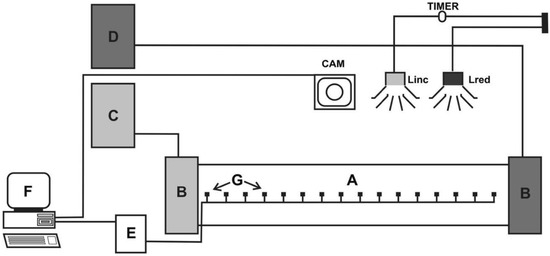
Figure 1.
Experimental set-up for the recording of thermoregulatory behaviour [18]. A—thermal gradient chamber; B—fluid chambers; C—cryostat; D—thermostat; E—recording keeper; F—computer; G—thermocouples; Linc—white light; Lred—red light; CAM—video camera.
The results obtained were averages ± SE. We used two-way ANOVA with subspecies and season of the year as the main factors to determine the statistical significance of the influence of the subspecies and the season of the year on the glycogen content in bees’ bodies and on their thermoregulatory behaviour. Differences between means for specific subspecies and seasons were determined using Tukey’s post hoc test. If p < 0.05 differences were considered statistically significant.
3. Results
3.1. Glycogen Content
Figure 2 shows a statistically significant effect of belonging to a given subspecies on the average total glycogen content in the body of worker bees (F(2,42) = 7.6743; p < 0.01). The highest values occurred in the Carniolan honeybee (244.77 ± 13.93 μg/g.b.w.= micrograms per one gram of body weight) and the lowest in the Caucasian honeybee (227.45 ± 28.12 μg/g.b.w.). The content of glycogen in the bodies of the Carniolan worker honeybees was significantly higher than in the Caucasian honeybees (p < 0.01), but it did not differ much from that for the Central European honeybee (236.38 ± 54.94 μg/g.b.w.).
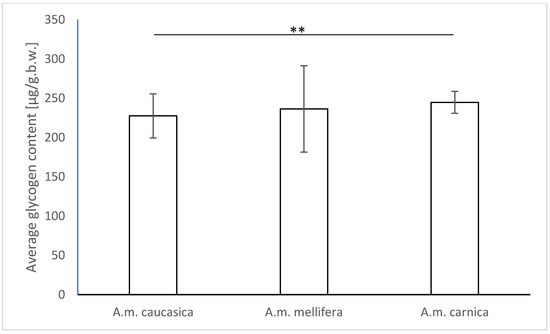
Figure 2.
Differences between the average glycogen contents (in μg/g.b.w.) in the organisms of bees from the following subspecies: Caucasian honeybee, Carniolan honeybee and Central European honeybee. Statistical significance was determined (** p < 0.01;).
Taking into account all the examined subspecies (Figure 3), we concluded that the glycogen content in the bodies of worker bees depended on the season (F(1,42) = 51.82; p < 0.001). In autumn bees preparing for wintering, it was 249.20 ± 33.45 μg/g.b.w. and was significantly higher than that for summer bees (223.20 ± 28.72 μg/g.b.w.; p < 0.001).
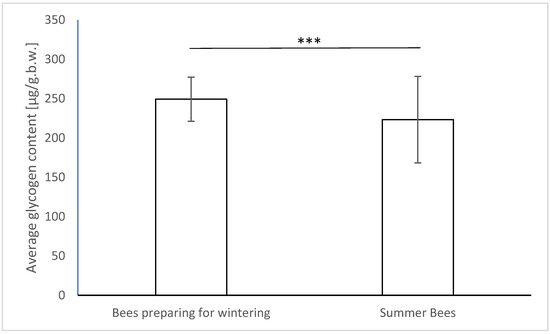
Figure 3.
Differences between the general average glycogen contents (in μg/g.b.w.) in bee organisms depending on the sampling season. Statistical significance was determined *** p < 0.001).
Figure 4 shows the interdependence of glycogen content in the bodies of worker bees on both the subspecies affiliation and the season (F(2,42) = 172.84; p < 0.001). In this way, we determined how the glycogen content changed depending on the season for a given subspecies. We noted that the trend of higher glycogen content in autumn bees preparing for wintering compared to summer bees, presented in the previous section, is met only by two subspecies—the Carniolan and Central European honeybees. Paradoxically, the Caucasian honeybee behaved oppositely. In addition, the highest glycogen content and, at the same time, the highest difference compared to summer bees (respectively: 181.44 ± 7.98 μg/g.b.w., and 291.32 μg/g.b.w. ± 6.28; difference > 100 μg/g.b.w.; p < 0.001) were found in the bodies of worker Central European honeybees preparing for wintering. The glycogen content in the body of worker bees of this subspecies preparing for wintering was significantly higher than that for all other subspecies preparing for wintering and summer bees. Summer bees achieved the lowest values compared to other subspecies in both seasons. In the Carniolan honeybee (autumn bees preparing for wintering: 256.10 ± 8.74 μg/g.b.w., summer bees 233.45 ± 10.17 μg/g.b.w.), the autumn–summer difference (22.65 μg/g.b.w.) was much smaller but also statistically significant (p < 0.01). The Caucasian honeybee differed from this scheme, in which the glycogen content of autumn bees preparing for wintering (200.19 ± 13.29 μg/g.b.w.) was significantly lower than for that of summer bees (254.70 ± 6.07 μg/g.b.w.; p < 0.001).
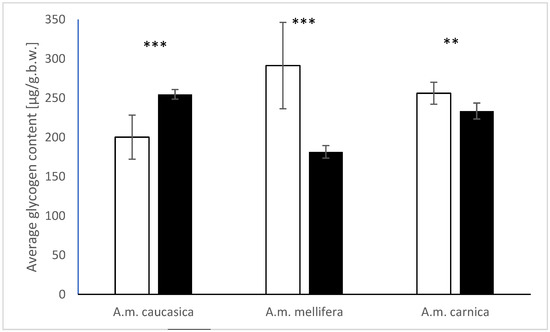
Figure 4.
Mean glycogen content (in μg/g.b.w.) in the organisms of worker bees of the subspecies studied in autumn (white bars) and spring (black bars). Statistical significance was determined (** p < 0.01; *** p < 0.001).
3.2. Thermoregulatory Behaviour
Figure 5 illustrates the influence of subspecies affiliation on the choice of ambient temperature by the honeybee workers. Since the differences in the selected ambient temperature between the tested subspecies reached a maximum of 1 °C (Caucasian honeybee 30.2 ± 1.43 °C; Central European honeybee 30.9 ± 2.73 °C; Carniolan honeybee 30.0 ± 1.90 °C), we did not find any statistically significant effect of subspecies affiliation on the choice of ambient temperature (F(2,28) = 0.32; p < 0.7314). Additionally, in the case of the season, although the temperature chosen by autumn bees preparing for wintering (31.0 ± 1.60 °C) was slightly higher than that for summer bees (29.8 ± 2.27 °C), there were no statistically significant differences (F(1,28) = 2.15, p < 0.15) (see Figure 6).
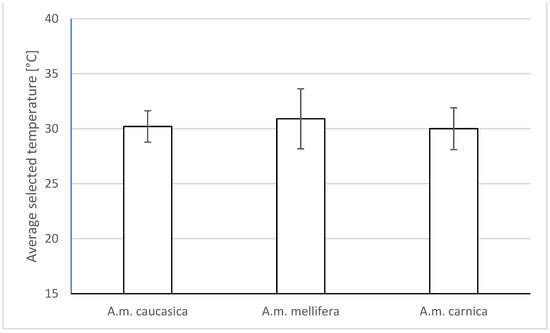
Figure 5.
Differences between average temperatures [°C] selected by worker bees from the following subspecies: Caucasian honeybee, Carniolan honeybee and Central European honeybee.
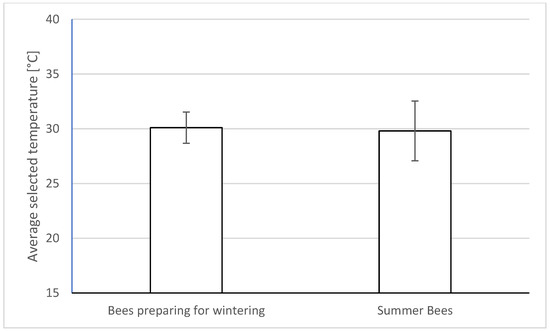
Figure 6.
Average ambient temperature [°C] selected by bees born in autumn and spring.
There was no statistical significance of differences in the mean ambient temperature selected between autumn bees preparing for wintering and summer bees both in the case of a given subspecies and between subspecies (F(2,28) = 3.97; p < 0.0303) (Figure 7). Because of the lack of differences between the subspecies, we can treat thermoregulatory behaviour as representing a feature characteristic of the entire honeybee (Apis mellifera L.) species.
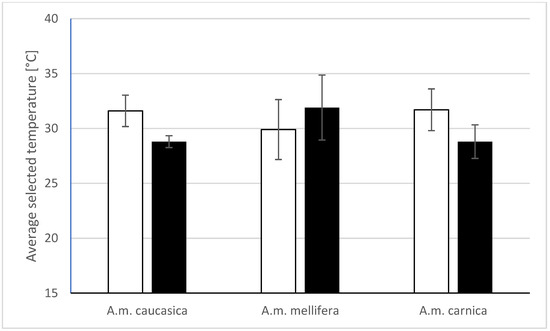
Figure 7.
Average ambient temperature [°C] selected by worker bees of the studied subspecies born in autumn (white bars) and spring (black bars).
4. Discussion
Overwintering ability is a crucial honeybee adaptation to unfavourable environmental conditions. It is derived from their spreading towards the north to different geographical areas and, as it can be assumed, behavioural and physiological responses, including changes in the chemical composition of body tissues.
In the present research, we studied the glycogen level depending on the season and subspecies affiliation. Additionally, we considered the worker honeybees’ thermoregulatory behaviours. In those terms, we compared three honeybee subspecies: Apis mellifera carnica P., Apis mellifera mellifera L. and Apis mellifera caucasica G. Our studies showed significant variability in total glycogen content per gram of body weight between worker bees belonging to individual subspecies and within given subspecies between autumn bees preparing for wintering and summer bees. The highest glycogen level was noted in the Carniolan honeybee, intermediate values in the Central European honeybee and the lowest in the Carniolan honeybee. Autumn bees preparing for wintering had more glycogen in their bodies than summer bees. However, there were no such differences in terms of their thermal behaviour. Despite some slight seasonal differences, bees of all tested varieties chose similar ambient temperatures. This lack of seasonal variation in the thermoregulatory behaviour of honeybees of all three subspecies studied is unique and puzzling to us. This is because, in our previous studies [19] conducted on adult worker bees of the Carniolan honeybee at an older age (guards and foragers, i.e., over 18 days of age), we noticed significant differences in thermopreferendum between different seasons. In spring, they chose a significantly lower temperature in the temperature gradient than in autumn. Perhaps the age of the bees studied explains this. Younger worker bees spend most of their lives inside the nest, where, due to the brood development, a stable temperature occurs.
Compared to the other studied subspecies, the pronounced discrepancy occurred in the case of the Caucasian honeybee. Similar differences concerned the choice of ambient temperature by queen bees belonging to the subspecies compared in this study [23]. The average glycogen content is the lowest for the Caucasian honeybee, and glycogen stores are higher in summer bees than in autumn bees preparing for wintering. Conversely, for the remaining subspecies—Carniolan honeybee and Central European honeybee—the glycogen content increases in autumn bees preparing for wintering. An explanation might be its geographical origin. The subspecies come from the Greater and Lesser Caucasus mountain areas, with a harsh climate, lower temperatures and longer winters than in the lowland regions, from which the Carniolan honeybee (A. m. carnica P.) and Central European honeybee (A. m. mellifera L.) come. There are also some anatomical and physiological differences. Unlike the other two subspecies studied, Caucasian honeybees are characterised by smaller body sizes and thus the limited ability to accumulate heat inside the body. They also form smaller colonies. In the climatic conditions to which they are adapted, the difficulty of obtaining food in early spring implies the need to have enough glycogen reserves to resume activity during the spring awakening of the colony than during the colony preparation for overwintering. Bees, both farmed and wild, are increasingly dealing with an increase in the average temperature on Earth, which entails unusually mild winters. In this way, the impact of a warming climate on the survival, overwintering and foraging condition of the examined honeybee subspecies gains importance. Under the milder environmental conditions in which we performed our study, the Caucasian honeybee does not need to accumulate such large glycogen stores to survive the winter. Although, even this amount is probably enough to keep these bees alive for a long time. On the other hand, the lower glycogen content in the spring for the Central European bee, characterised by larger size and forming larger colonies, may cause slow spring development and poor penetration of early flows caused by poor flower availability at this time of year. This can be beneficial for these bee colonies, but it can also cause problems for them. In this case, the relationship between physiological adaptations and behaviour is visible.
The results of our study might be affected by the measurement of the total glycogen content in the whole body of the worker bee instead of a specific organ. These were preliminary analyses aimed at determining general relationships. We plan to perform analogous comparative studies of the same material, which will concern individual isolated organs of the bee body: the head, flight muscles, and fat body. There is some data on the level of glycogen in different body organs of bees under various physiological conditions. The overall glycogen concentration in honeybees is low [24,25]. Panzenböck and Crailsheim [10] showed that the amount of glycogen in the honeybee is 0.1–0.3% of body weight, while in adult Drosophila individuals, the amount of glycogen ranges from 1.3 to 6% of body weight [26,27]. These percentages, converted to micrograms per gram of body weight, would be close to those obtained for the bees in our study. Large food reserves accumulated in the honeycomb of the colony balance likely decreased glycogen stores in individual bees. Outside the winter season, a single forager must store enough energy in its body for one flight. Even during that flight, it may stop and collect nectar.
Glycogen storage varies in individual castes of bees at different ages and depends on the season [28]. Young honeybee drones have more glycogen in the body than older ones. They may need to store more of an energy source because they are less fed than young workers. The highest content of glycogen in drones, apart from juveniles, is stored in the head [10]. The principal glycogen storehouses are glial cells nourishing the photoreceptors [29]. This arrangement may be due to the drones’ large, compound eyes, which are necessary for orientation on a wedding flight. In worker bees, the amount and placement of glycogen depend on age. Older workers generally have more glycogen than younger ones. They have the most glycogen in the abdomen and the least in the thorax. Young forager bees have a higher glycogen content because they replenish their reserves after feeding on sugar, while famished foragers returning to the nest show a significantly reduced glycogen content in the flight muscles [11]. In turn, in queen bees, the amount of glycogen is estimated at the same levels as in worker bees. Interestingly, the glycogen content is higher in the queen bee’s thorax than in the abdomen and the smallest in the head. Muscle and body fat store the glycogen for flight in both female forms: worker and queen bees [10]. The glycogen content in honeybees changes seasonally; they have little glycogen stores in summer due to their constant access to nectar. For forager bees, storing a certain amount of glycogen needed for flight is essential because of its energetic expensiveness. The lonely worker bee far away from the hive cannot always stop and feed. When this is not possible, it uses up its internal glycogen stores. In winter, worker bees use energy to produce heat to warm up and maintain a high temperature in the nest. Glycogen reserves can also be significantly affected by the infestation of bees by Varroa destructor [30].
We presented the obtained results against the background of poor data in the literature we were able to find on the glycogen demand in various physiological conditions and its content in different organs of the bee’s body. Undoubtedly, an achievement of our work is the comparative analysis of three subspecies of honeybees most often used for breeding by Polish beekeepers, because there are few such comparisons. The results of our research indicate the importance of the geographical origin of the three subspecies studied, which impacts the course of their evolution and provides them with favourable functional characteristics to use in our climatic conditions. Although this is due to breeding selection, each of the studied subspecies adapted to unfavourable winter conditions in a specific way, and their characteristic anatomical and physiological features modified these adaptations. At present, we should focus on the impact of climate warming, resulting in late and warm winters, on the anatomical and physiological parameters of individual insects and the annual development cycle of bee colonies.
5. Conclusions
In this study, we determined the glycogen content in the bodies of three varieties of honeybees: Carniolan, Caucasian and Central European. We also studied their thermal preferences. We conducted experiments on two groups: autumn bees preparing for wintering and summer bees. We found that:
- (1)
- Bees’ subspecies affiliation, and thus their geographic origin, affects their glycogen concentration;
- (2)
- The time of year in which honeybee workers are born determines the glycogen content of their bodies;
- (3)
- Neither the geographic origin nor the season in which they were born has an influence on the preferred temperature;
- (4)
- There is a discrepancy between the Caucasian bees and the remaining subspecies in terms of the glycogen content differences between the group of autumn bees preparing for wintering and the group of summer bees.
Author Contributions
Conceptualization, P.G.; writing—original draft preparation, P.G.; review and editing, P.G.; supervision, P.G.; investigation, J.B.; resources, J.B.; data curation, J.B. and K.P.; investigation, K.P.; methodology, K.P.; software, B.P.; formal analysis, B.P. All authors have read and agreed to the published version of the manuscript.
Funding
This research received no external funding.
Institutional Review Board Statement
Not applicable.
Informed Consent Statement
Not applicable.
Data Availability Statement
The data presented in this study are available on request from the corresponding author.
Acknowledgments
We would like to thank Sławomir Wnuk (the owner of the family apiary in the Kujawsko-Pomorskie Voivodeship) and his relatives for their generous help in carrying out the research and for making the bee colonies available for research purposes.
Conflicts of Interest
The authors declare no conflict of interest.
References
- Fukuda, H.; Sekiguchi, K. Seasonal change of the Honeybee worker longevity in Sapporo, North Japan, with notes on some factors affecting the life-span. Jpn. J. Ecol. 1966, 16, 206–222. [Google Scholar] [CrossRef]
- Mattila, H.R.; Harris, J.L.; Otis, G.W. Timing of production of winter bees in honey bee (Apis mellifera) colonies. Insectes Sociaux 2001, 48, 88–93. [Google Scholar] [CrossRef]
- Southwick, E.E. Overwintering in Honey Bees: Implications for Apiculture. Insects Low Temp. 1991, 446–460. [Google Scholar] [CrossRef]
- Winston, M.L. The Biology of the Honey Bee; Harvard University Press: Cambridge, MA, USA, 1991. [Google Scholar]
- Prabucki, J. Pszczelnictwo [Beekeeping]; Wydawnictwo Promocyjne ”Albatros”: Szczecin, Poland, 1998. (In Polish) [Google Scholar]
- Corona, M.; Velarde, R.A.; Remolina, S.; Moran-Lauter, A.; Wang, Y.; Hughes, K.A.; Robinson, G.E. Vitellogenin, juvenile hormone, insulin signalling, and queen honey bee longevity. Proc. Natl. Acad. Sci. USA 2007, 104, 7128–7133. [Google Scholar] [CrossRef]
- Remolina, S.C.; Hafez, D.M.; Robinson, G.E.; Hughes, K.A. Senescence in the worker honey bee Apis mellifera. J. Insect Physiol. 2007, 53, 1027–1033. [Google Scholar] [CrossRef]
- Steinmann, N.; Corona, M.; Neumann, P.; Dainat, B. Overwintering Is Associated with Reduced Expression of Immune Genes and Higher Susceptibility to Virus Infection in Honey Bees. PLoS ONE 2015, 10, e0129956. [Google Scholar] [CrossRef]
- Božanić, D.K.; Luyt, A.S.; Trandafilović, L.V.; Djoković, V. Glycogen and gold nanoparticle bioconjugates: Controlled plasmon resonance via glycogen-induced nanoparticle aggregation. RSC Adv. 2013, 3, 8705–8713. [Google Scholar] [CrossRef]
- Panzenböck, U.; Crailsheim, K. Glycogen in honeybee queens, workers and drones (Apis mellifera carnica Pollm.). J. Insect Physiol. 1997, 43, 155–165. [Google Scholar] [CrossRef] [PubMed]
- Leta, M.A.; Gilbert, C.; Morse, R.A. Levels of hemolymph sugars and body glycogen of honeybees (Apis mellifera L.) from colonies preparing to swarm. J. Insect Physiol. 1996, 42, 239–245. [Google Scholar] [CrossRef]
- Döke, M.A.; Frazier, M.; Grozinger, C.M. Overwintering honey bees: Biology and management. Curr. Opin. Insect Sci. 2015, 10, 185–193. [Google Scholar] [CrossRef] [PubMed]
- Carroll, N.V.; Longley, R.W.; Roe, J.H. The determination of glycogen in liver and muscle by use of anthrone reagent*. J. Biol. Chem. 1956, 220, 583–593. [Google Scholar] [CrossRef]
- Roe, J.H.; Dailey, R.E. Determination of glycogen with the anthrone reagent. Analytical Biochemistry 1966, 15, 245–250. [Google Scholar] [CrossRef] [PubMed]
- Templeton, M. Microdetermination of glycogen with anthrone reagent. J. Histochem. Cytochem. Off. J. Histochem. Soc. 1961, 9, 670–672. [Google Scholar] [CrossRef] [PubMed]
- Roman, A. Podstawy Pszczelarstwa [The Basics of Beekeeping]; Wydawnictwo Akademii Rolniczej we Wrocławiu: Wrocław, Poland, 2006. (In Polish) [Google Scholar]
- Grodzicki, P.; Caputa, M. Social versus individual behaviour: A comparative approach to thermal behaviour of the honeybee (Apis mellifera L.) and the American cockroach (Periplaneta americana L.). J. Insect Physiol. 2005, 51, 315–322. [Google Scholar] [CrossRef] [PubMed]
- Grodzicki, P.; Caputa, M. Photoperiod influences endogenous rhythm of ambient temperature selection by the honeybee Apis mellifera. J. Therm. Biol. 2012, 37, 587–594. [Google Scholar] [CrossRef]
- Grodzicki, P.; Caputa, M. Diurnal and seasonal changes in thermal preference of single, isolated bees and small groups of bees (Apis mellifera L.). J. Insect Behav. 2014, 27, 701–711. [Google Scholar] [CrossRef]
- Grodzicki, P.; Caputa, M.; Piechowicz, B. Effect of the own colony odor on olfactory and thermal preferences of the honeybee (Apis mellifera) workers. Apidologie 2018, 49, 209–219. [Google Scholar] [CrossRef]
- Grodzicki, P.; Piechowicz, B.; Caputa, M. The effect of the queen’s presence on thermal behavior and locomotor activity of small groups of worker honey bees. Insects 2020, 11, 464. [Google Scholar] [CrossRef] [PubMed]
- Grodzicki, P.; Piechowicz, B.; Caputa, M. Effect of the own vs. foreign colony odor on daily shifts in olfactory and thermal preference and metabolic rate of the honey bee (Apis mellifera) workers. J. Apic. Res. 2020, 59, 691–702. [Google Scholar] [CrossRef]
- Bacia, J.; Grodzicki, P. Geographical origin reflected in physiology: Differences in thermal behaviour of three honeybee Apis mellifera subspecies. J. Physiol. Pharmacol. 2021, 72, 57. [Google Scholar]
- Neukirch, A. Dependence of the life span of the honeybee (Apis mellifica) upon flight performance and energy consumption. J. Comp. Physiol. 1982, 146, 35–40. [Google Scholar] [CrossRef]
- Harrison, J.M. Caste-specific changes in honeybee flight capacity. Physiol. Zool. 1986, 53, 175–187. [Google Scholar] [CrossRef]
- Williams, C.M.; Barness, L.A.; Sawyer, W.H. The utilization of glycogen by flies during flight and some aspects of the physiological ageing of drosophila. Biol. Bull. 1977, 84, 263–272. [Google Scholar] [CrossRef]
- Barnes, W.S. Glycogen storage in normal and wing-mutant strains of Drosophila melanogaster. Comp. Biochem. Physiol. Part A Physiol. 1994, 109, 487–494. [Google Scholar] [CrossRef] [PubMed]
- Hrassnigg, N.; Crailsheim, K. Differences in drone and worker physiology in honeybees (Apis mellifera). Apidologie 2005, 36, 255–277. [Google Scholar] [CrossRef]
- Tsacoppoulus, M.; Veuthey, A.L. The nutritive function of glia in a crystal-like nervous tissue: The retina of the honeybee drone. Dev. Neurosci. 1993, 15, 336–342. [Google Scholar] [CrossRef] [PubMed]
- Łopieńska-Biernat, E.; Farjan, M.; Żółtowska, K.; Dmitryjuk, M.; Lipiński, Z.; Szypulska, E. Supplementing With Vitamin C the Diet of Honey Bees Parasitized With Varroa destructor: Effect on Carbohydrate Metabolism. J. Agric. Sci. 2019, 11, 1. [Google Scholar] [CrossRef]
Disclaimer/Publisher’s Note: The statements, opinions and data contained in all publications are solely those of the individual author(s) and contributor(s) and not of MDPI and/or the editor(s). MDPI and/or the editor(s) disclaim responsibility for any injury to people or property resulting from any ideas, methods, instructions or products referred to in the content. |
© 2023 by the authors. Licensee MDPI, Basel, Switzerland. This article is an open access article distributed under the terms and conditions of the Creative Commons Attribution (CC BY) license (https://creativecommons.org/licenses/by/4.0/).